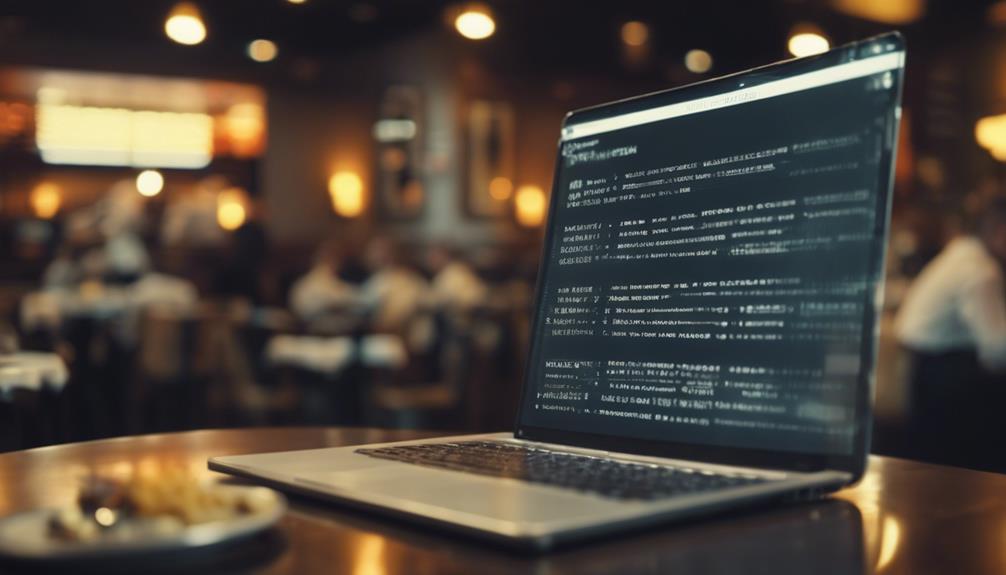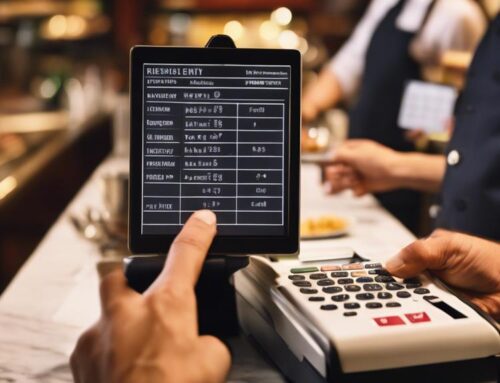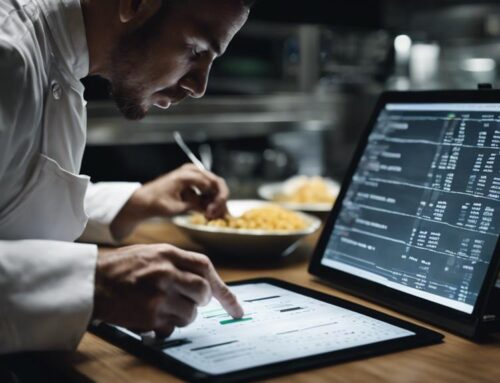To maintain the confidentiality of restaurant menu data during entry, ensure strict measures. Start with setting up password protection for secure access. Implement restricted access with specific permissions. Utilize encryption algorithms like AES or RSA for data security. Store encrypted data on secure servers. Keep security protocols updated regularly. Monitor and track data access. Train staff on data confidentiality practices. For a comprehensive understanding of these measures, explore further details provided in the comprehensive guide on data security.
Establish Password Protection
To secure menu data confidentiality, establish password protection to control access to sensitive information. Data encryption plays a crucial role in ensuring that your menu data remains secure. By encrypting the data, you are converting it into a code that can only be accessed or read by individuals with the correct decryption key. This adds an extra layer of security to prevent unauthorized access to the information.
Access control is another essential aspect of maintaining menu data confidentiality. Implementing strong password protection ensures that only authorized personnel can view or modify the data. When setting up passwords, make sure to use a combination of letters, numbers, and special characters to enhance security. Regularly updating passwords and restricting access based on job roles can further strengthen your data protection measures.
Implement Restricted Access
To enhance menu data confidentiality, you must establish limited user permissions, ensuring that only authorized personnel can access sensitive information. Secure login credentials should be implemented to prevent unauthorized entry, safeguarding the data from potential breaches. Conducting regular access audits is crucial to monitor who has accessed the menu data and to identify and address any suspicious activity promptly.
Limited User Permissions
Consider assigning specific user roles and permissions to ensure restricted access and maintain menu data confidentiality effectively. User monitoring is crucial to track activities and ensure compliance with data protection regulations. By implementing data classification, sensitive menu information can be appropriately labeled and accessed only by authorized personnel. Limiting user permissions based on job roles and responsibilities helps prevent unauthorized access to confidential data. Regularly review and update user permissions to align with the principle of least privilege, granting users only the access necessary to perform their tasks. This approach enhances data security by minimizing the risk of data breaches and unauthorized disclosures. Properly managed limited user permissions are a fundamental aspect of safeguarding restaurant menu data.
Secure Login Credentials
Maintain menu data confidentiality effectively by implementing restricted access through secure login credentials to ensure only authorized personnel can access sensitive information. Utilize two-factor authentication or biometric verification to add an extra layer of security. Encourage the use of secure password managers to store and manage login credentials securely. Multi-factor authentication should be enforced, requiring users to provide multiple forms of verification before gaining access to the system. By incorporating these measures, you can significantly reduce the risk of unauthorized access to restaurant menu data. Remember, the protection of sensitive information is crucial in maintaining the confidentiality and integrity of your menu data.
Regular Access Audits
Conduct regular access audits to monitor and control the permissions granted to individuals accessing menu data, ensuring compliance with security protocols. Access control is crucial to protect sensitive information from unauthorized exposure. By regularly reviewing who has access to the menu data and what level of access they possess, you can identify and address any potential security risks promptly. These audits help guarantee that only authorized personnel can view or modify the data, enhancing data protection measures. Maintaining a clear log of access permissions and changes is essential for accountability and compliance purposes. Regular access audits contribute significantly to upholding the confidentiality of restaurant menu data and mitigating the risk of data breaches.
Utilize Encryption Techniques
To enhance the security of your menu data, implementing encryption techniques is essential in safeguarding sensitive information from unauthorized access. Data encryption methods play a crucial role in protecting your restaurant’s menu data. When entering data into your system, it is vital to follow strict data entry security protocols to ensure that all information is encrypted before storage. Utilizing encryption algorithms such as Advanced Encryption Standard (AES) or Rivest-Shamir-Adleman (RSA) can help in securing the confidentiality of your menu data. These encryption techniques transform the data into ciphertext, making it unreadable to anyone without the decryption key. By incorporating encryption methods into your data entry processes, you add an extra layer of protection against potential breaches or data leaks. Remember to regularly update your encryption keys and algorithms to stay ahead of emerging security threats and ensure the ongoing safety of your restaurant’s sensitive menu data.
Store Data on Secure Servers
When safeguarding your restaurant’s menu data, ensuring its confidentiality involves storing the information on secure servers. Data encryption is a crucial aspect of protecting this sensitive data. By encrypting the menu data before storing it on secure servers, you add an extra layer of security that prevents unauthorized access to the information. Encryption converts the data into a code that requires a decryption key to be read, making it extremely difficult for cyber threats to compromise.
Secure storage is another essential element in maintaining the confidentiality of your restaurant’s menu data. Secure servers provide a protected environment where the encrypted data can be stored without the risk of exposure. These servers are designed with advanced security measures to prevent data breaches and ensure that only authorized personnel can access the information when needed.
Regularly Update Security Measures
Updating security measures regularly is crucial for maintaining the integrity and confidentiality of your restaurant’s menu data. To ensure the protection of sensitive information, conduct regular audits of your security protocols. These audits should assess the effectiveness of existing measures and identify any potential vulnerabilities that could compromise data security.
In addition to audits, implementing data encryption is essential for safeguarding menu data. Encryption converts the data into a code that can only be accessed with the correct decryption key, making it unreadable to unauthorized users. By encrypting your menu data, you add an extra layer of security that helps prevent data breaches and unauthorized access.
Regularly updating security measures not only protects your restaurant’s menu data but also helps you stay compliant with data protection regulations. By staying proactive and vigilant in enhancing your security practices, you demonstrate a commitment to maintaining the confidentiality and integrity of your menu data.
Monitor and Audit Data Access
Ensure robust monitoring and auditing of data access to maintain the security and confidentiality of your restaurant’s menu data. Implementing effective access control measures and data monitoring processes is crucial in safeguarding sensitive information. Here are key steps to help you in monitoring and auditing data access:
- Implement Role-Based Access Control: Assign specific access levels to employees based on their roles to limit unauthorized data access.
- Utilize Logging and Tracking Systems: Implement systems that log all data access activities, enabling you to track who accessed the menu data and when.
- Regularly Review Access Logs: Conduct routine reviews of access logs to identify any unusual or unauthorized access attempts.
- Enforce Multi-Factor Authentication: Require multiple forms of identification to access menu data, adding an extra layer of security.
- Perform Periodic Audits: Conduct regular audits to ensure compliance with data access policies and identify any potential security gaps.
Train Staff on Data Confidentiality
To enhance the security of your restaurant’s menu data, train your staff comprehensively on data confidentiality protocols. Role-based training is essential in ensuring that each team member understands their specific responsibilities regarding data protection. By tailoring training sessions to different roles within the organization, you can emphasize the importance of confidentiality at all levels.
Additionally, make sure all staff members sign confidentiality agreements. These agreements outline the expectations regarding the handling of sensitive information and serve as a legal safeguard for your restaurant. Include clear guidelines on how to handle menu data, who has access to it, and the consequences of breaching confidentiality.
Regularly review and update these agreements to align with any changes in data protection laws or internal processes. By reinforcing the significance of confidentiality through training and agreements, you create a culture of awareness and responsibility among your staff, ultimately safeguarding your restaurant’s menu data.
Frequently Asked Questions
What Are the Potential Consequences of a Data Breach in a Restaurant Menu Data System?
Imagine the fallout of a data breach in a restaurant’s system: financial liabilities, privacy breaches. To prevent such disasters, implement data encryption and robust cybersecurity measures. Safeguarding menu data is crucial for maintaining trust and compliance.
How Can Restaurant Owners Ensure That Their Staff Understand the Importance of Maintaining Menu Data Confidentiality?
To ensure staff grasp menu data confidentiality importance, prioritize employee training. Emphasize data encryption benefits and menu data security best practices. Implementing these measures will fortify your restaurant’s defenses and safeguard sensitive information effectively.
Are There Any Specific Regulations or Laws That Restaurants Need to Comply With in Order to Protect Menu Data?
To protect menu data, ensure compliance with data encryption standards. Regulations may vary, but prioritize safeguarding customer preferences and menu pricing. Adhering to these measures is crucial for maintaining confidentiality and meeting legal requirements.
How Can Restaurants Ensure That Third-Party Vendors or Contractors Who Have Access to Menu Data Also Follow Strict Confidentiality Protocols?
To ensure confidentiality with vendors, enforce strict data encryption and access control measures. Require comprehensive confidentiality training for vendors, and clearly outline confidentiality expectations in vendor agreements. Regularly monitor and audit vendor compliance to uphold data security.
What Steps Can Restaurants Take to Detect and Prevent Unauthorized Access to Menu Data?
To safeguard menu data, you must prioritize employee training on data security practices. Implement robust data encryption methods to safeguard against unauthorized access. By diligently following these measures, you can fortify your restaurant’s data confidentiality with an ironclad shield.




